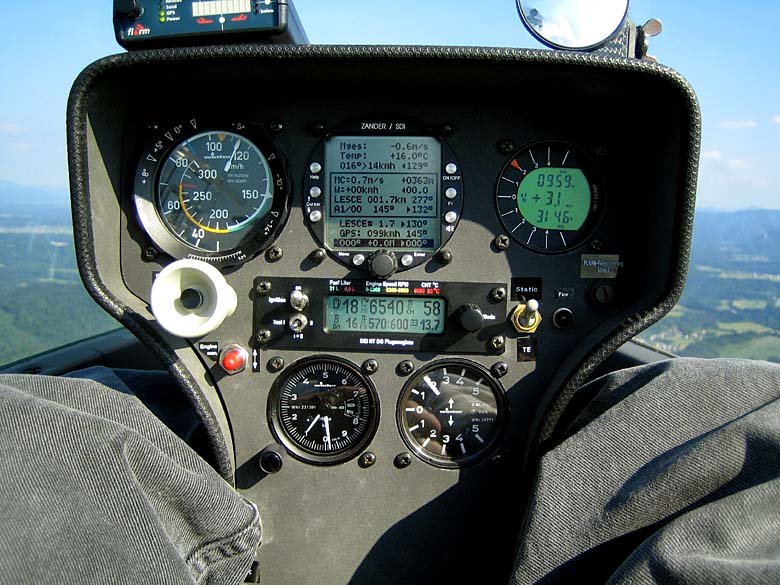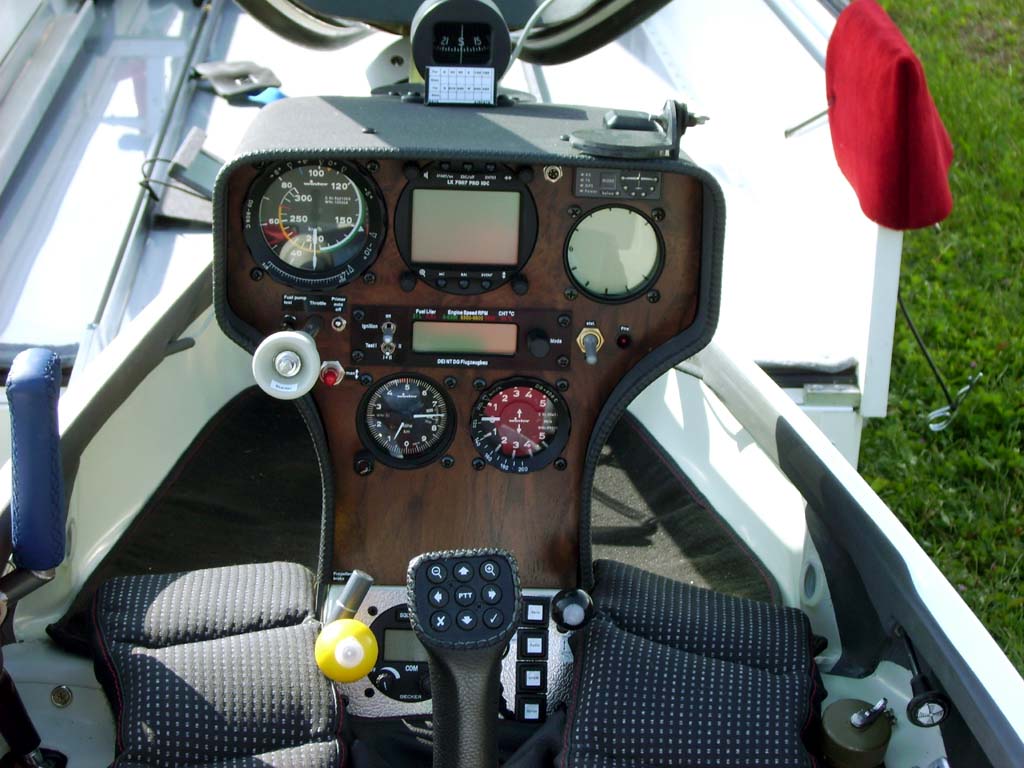DEI-NT – DG Flugzeugbau’s engine control unit with new technology
The DEI has almost become a hallmark for DG. Since the introduction of motorgliders, i.e. since the first DG-400 in 1982, the Digital Engine Indicator has been an engine control system unique to DG. In the early days the unit consisted mainly of relays and worked on electro-mechanical principles. Later on we started using a small computer with a separate electronic box which controlled the high starter currents. You might have seen the detailed reports about the system. As ever, our company’s motto was:
Make it as easy as possible – for the pilot, not necessarily for the manufacturer!
However, electronics in particular have undergone an impressive evolution since then, which prompted us to subject the DEI to a major overhaul and apply the above-mentioned motto even more rigorously.
The new DEI with the latest technology encompasses above all the two following leading principles:
- It does – in connection with the automatic propeller brake (option) – all the work on the power plant for the pilot and it monitors all the functions to an extent previously unheard of
- It offers a wealth of alerts and diagnostic functions if something doesn’t quite work as it should.
It may look simple on the outside, but it certainly is anything but on the inside, so the major task was not the soldering of some components but the development of the software behind it. As usual we entrusted Schicke-Electronic to take this job on. Without bragging we can probably still call the result a quantum leap in engine control systems!
(The expert will notice immediately that distracted by taking the photos Im flying too fast
and am thus over-revving the engine as well as have an insufficient climb rate!)
What you’ll notice immediately:
There is no “on” switch. This means there is one less thing to do.
The unit is switched on with the master switch and remains switched on, even during unmotorised gliding flight but more about this later! Power consumption is negligible.
With the rotary/push button on the right you scroll through the various pages of the menus and enter the desired settings. Apart from this the only other control you’ll see is the ignition switch which exclusively controls the engine, and on the DG-808C also the ignition circuit tester.
This is what the display might look in flight – it’s all pretty self-explanatory. In the bottom you see the EGT – if you have installed EGT-probes.
“All Systems go!”
If anything unusual happens the display has a wealth of alerts on offer, showing something like e.g. the following:
Here someone tries to make a gear-up landing.
Over-revving the engine would be displayed in a similar way.
There are a number of pages related to retracting and extending the engine, so the pilot can monitor directly what is happening behind him or her. For safety reasons we will not get rid of the little mirror for a direct visual check of what’s going on behind you, but it is not really necessary anymore:
Engine extended!
This indicates that the engine is being retracted automatically.
As soon as the engine compartment doors are shut you will see the gliding page, which mainly states times for outside temperature and voltage.
Stall warning:
The crucial additional safety feature however is the integrated stall warning, which is always activated and looks after your safety. Some of you might know that 5 years ago a very good friend of mine crashed because he apparently didn’t notice that he was flying far too slowly. This additional safety feature is a consequence of his accident and will save lives maybe yours! Only chances are that you would not even notice. You would just speed up a bit as the stall warning goes off, and that would be all…
You only need to calibrate the stall warning once for further information on how to do it please consult the manual. Once that’s done it works correctly, irrespective of speed and wing loading, which distinguishes it from the stall warning you get in on-board computers: Those are always set to a certain wing loading and will therefore have to be reset when you dump your water ballast which is often not done.
The stall warning works on the basis of two sensors which measure the pressure difference in the nose of the glider not with flaps in the wings or other “aerodynamic cruelties”. In the example it shows 0.08. When the difference is more than 0.30 the warning should be activated.
I know that a lot of pilots argue that such a stall warning is superfluous in a glider and just not practical. According to those pilots it’s superfluous because accidents will only happen to “others”; while allegedly it’s not practical because as a pilot you would quite often have to fly close to stall speed.
I won’t waste any time on the first argument, but the second one is also wrong:
If you fly below stall speed in a glider with a modern profile you fly inefficiently and badly! You may not notice it as much as you do in an older model, because the elevator buffet is not quite as noticeable as on an older profile, but you will climb more slowly or not at all.
If the stall warning goes off you are very simply flying too slowly, not optimized and you are in danger. This is exactly what the DEI-NT is designed to show you.
We will decide in the course of the flight tests whether the stall warning will be in the form of a sound alert or through a vibrating stick. Additionally it will show a warning in the display. Of course the really “tough” pilots can deactivate the stall warning by calibrating it higher than 0.50 to go off at a speed when the glider is already in a mushing stall or worse.
There is a long and rather personal article on the subject “stall warning” on our website. Even though it is 5 years old it only needed minimal tweaking to be as relevant as when it was first written. You really ought to read it again!
Further alerts in the new DEI-NT are:
Main Switch:
Did you never forget to switch off the electricity? After a while probably the battery will be empty!
When the glider is standing still without any activity, a warning will come up after 15 minutes.
When you raise the gear with V=0 – during loading into a trailer – the warning will come up immediately.
Of course you can switch off the warning too.
Undercarriage warning I:
An undercarriage warning should be installed into each glider, following the motto that there are only two kinds of pilots:
Those who have landed wheels up and those who will.
Undercarriage warning II:
What do you think of this then:
After you’ve flown with the wheel down for 4 minutes you are prompted to put the wheel up. Lets be honest:
Has it never happened to you that you forgot to retract the undercarriage after the launch?
It steadily happens to me – that is why you have such a warning!
Spoiler warning:
If you forget to lock the airbrakes before the launch this does not necessarily lead to a dangerous situation anymore due to the Piggott hook fitted as standard. However this is not a desirable situation, so the DEI alerts you to it.
Low Fuel:
Fuel is really low now! Only 4 litres left.
Battery warning:
Two different warnings are generated: Low battery and Battery overcharged, i.e. both low voltage as well as too high voltage due to a fault in the charger or generator.
Temperature warning:
Warns about excessive temperature at the cylinder head (coolant), of the exhaust gases or within the electronics box
Starter Run:
This monitors the starter motor:
It alerts you when the starter draws current but is not engaged, and it does the same when the starter is engaged and being cranked by the engine. In both cases you should immediately stop the engine!
Water Freeze:
Warning: Ambient temperature is low, dump the water ballast to avoid freezing. This affects the water in the fin tank in particular as it cools down much quicker than the water in the wing tanks. This warning can be deactivated, when you are flying without water ballast.
The last four types of alerts are designed to help you avoid expensive
and avoidable damage to your glider if something is not working correctly.
More useful features of the new DEI-NT:
Of course there’s a logbook (which any on-board computer will also have), and a page for engine hours and information on the service intervals.
However:
In addition you can retrieve this data together with a variety of diagnostic information using your computer, and you can then export the data to Excel for analysis. These are:
Date, launch time, landing time, engine run
Flight duration, max. engine revs, max. coolant temperature, max. cylinder head temperature, duration of potentially exceeding the limits
Fault alerts like:
Disconnection between DEI and control unit, defect on proximity switch, tripped spindle
drive circuit breaker or malfunction of the spindle drive.
Failure of the electric fuel pump, coolant pump, tank pump, primer valve, ambient temperature sensor, EGT sensor or tank sensor.
Malfunction of the generator, the brake motor, excessive temperature of the control unit, malfunction of the prop stopper.
So you can see for yourself when something in the system is not quite right!
Commercial operators might also appreciate the fact that they can easily check the data to see whether a customer has used the engine within its specifications.
What is even more important, though:
All these things are checked once during start-up, so you can be quite certain that the engine control will work correctly once you open the throttle.
And that improves the safety of the complete system.
This article can of course only show a snapshot of the possibilities the new DEI-NT offers. You can see more details in the DEI-NT manual, which is incorporated in the glider manual.
Such a highly sophisticated electronic device will undergo regularly development.
As new versions of the DEI software become available it is possible to upgrade the DEI while it is installed in the glider. In order to perform the upgrade you will need to have a little adapter. Our representatives will be able to perform the upgrade but the owners of a DG-808C, DG-1000T or LS8-st may find it is easier to have such a device of their own. It can be ordered from us for a price of about 80,– Euro plus tax and freight cost.
The new DEI-NT is standard in all new DG-808C Competition, DG-1000T and LS8s-t.
It will enable you to do what we all like best:
“Simply Flying!”
– friedel weber –
Translation: Claudia Büngen
Retrofit of the new DEI-NT
We are not able, to install this device in the DG-400 or the DG-600M.
A retrofit for a DG-800B might be possible but it will be rather expensive. The DEI-NT as well as the electronic box has to be replaces and the cable harness too. We are in doubt if any owner of a glider is be willing to pay for such an installation.
DEI-NT PowerPoint Presentation
This presentation made by Wilhelm Dirks shows the complete development from the oldest DEI of the DG-400 in 1981 to the newest version of 2005 in the DG-808C. It contends many nice pictures and gives a good overview about all functions.
Attention: The download of this presentation is 42 MB in size!
Engine Control System for Motorgliders
(From Aerokurier 2 / 2005)
The DEI-NT offers fewer operating elements but
a whole host of information for DG-Motorgliders.
Bruchsal: Onwards from their first motorglider, the DG-400, DG-Flugzeugbau in Bruchsal aimed their motorized gliders to have extensive automation for the control and supervision of all functions of their retractable propulsion systems. The supervisory control and data acquisition device DEI (Digital Electronic Indicator) was developed to that end in collaboration with Schicke-Electronic. The especially critical phase of breaking and positioning of the propeller, retraction of the motor or propeller mast, up to closing of the engine bay doors happens automatically with the DEI. The pilot can concentrate without distraction and utilize the thermal found prior to engine shutdown, everything to serve the basic principle to make things as easy as possible for the pilot. Soaring will be much safer for it in the end.
There are few things in the world which can’t be improved, extended, made even safer. Bearing that in mind DG-Flugzeugbau and Schicke-Electronic now reviewed and revised the DEI. The result is the ‘DEI New Technology’ (DEI-NT), which was exhibited first time at the AERO in Friedrichshafen. DG introduced a supervisory and control instrument with a number of additional functions and improved display of system condition. Further included is an abundance of new diagnostic tools.
The DEI however received a substantial extension of it’s capabilities with the integrated stall warning. As it were an angle of attack is obtained from two pressure readings. Calibration of the stall warning takes place only once in straight and level flight; correct indication is then given in all other phases of flight, e.g. turns, extended air brakes and range of wing loadings. A vibrating pad in the control stick alerts the pilot to the impending stall.
The functionality of the DEI has increased, the number of operating elements in contrast have been reduced. The On / Off switch has disappeared as well. The unit is now put into service with the main switch and remains activated throughout the whole flight. Power drain is negligible according to DG-Flugzeugbau.
Paging through the various menus and entering of settings is accomplished with a dial / push button combination. There is only an ignition switch and for engines with double ignition, ignition circuit tester in addition to that.
Warning messages alert the pilot to faults and critical conditions, e.g. RPM, temperatures, tank content. Various combinations during retraction and extension of engine / propeller mast are also shown on the display; the rear view mirror becomes redundant.
The DEI incorporates a log book for flight and engine run times as too. Furthermore operating data exceeding normal values like max rpm or temperature are retained in memory for diagnostics.
It is intended to fit the new DEI-NT to the DG-808C, the DG-1000T as well as the LS8-st.
Translation: Rolf A. Buelter, Melbourne-Australia








